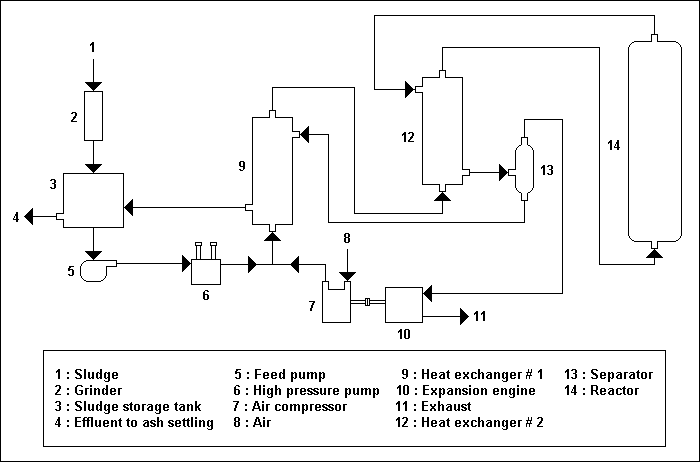| Solids concentration ( % ) | Settling velocity ( ft / h ) |
| 0.4 | 7.0 |
| 0.8 | 1.9 |
| 1.2 | 0.7 |
| 1.6 | 0.28 |
| 2.0 | 0.13 |
- For SS = 0.4 % ; solid flux = ( 0.4 ) ( 62.4 / 100 ) ( 7.0 ) ( 24 ) = 41.9 lb / ft 2 . day
( Note : cu ft of water = 62.4 lb of water )
- The results are plotted in figure given below ;
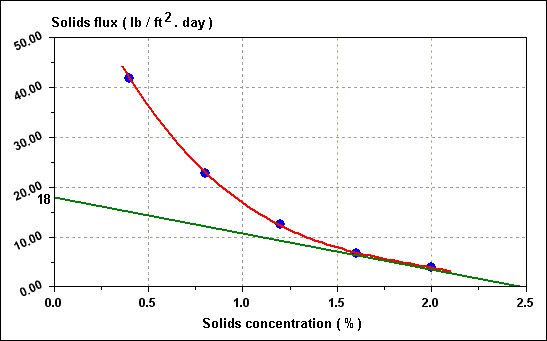
The design solids flux or limiting solids flux is obtained by drawing the tangent to the solids flux curve from the desired underflow SS concentration of 2.5 percent.
G L = 18 lb / ft 2 . day
The required surface area of the gravity thickener is ;
A = [ ( 0.10 ) ( 1.50 / 100 ) ( 10 6 ) ( 8.34 ) ] / ( 18 ) = 695 ft 2
( Note : 8.34 lb / MGD = 1 mg / L )
R ( % ) = [ ( 48 ) ( 0.47 + P ) 0.37 ] / ( Q 0.52 )
Where ; R : solid recovery efficiency ( % ), P : polymer dosage ( lb / ton of sludge ) and Q : hydraulic loading ( GPM / ft 2 ). For 4 % solids concentration, the sludge flow is ;
Q ' = ( 10,000 ) ( 1 / 0.04 ) ( 1 / 8.34 ) = 30,000 gal / day
If the centrifuge will operate for 8 hours per day, the total sludge flow to the centrifuge is ;
Q ' = ( 30,000 ) ( 24 / 8 ) = 90,000 gal / day = 62.5 GPM
At 95 % solids recovery, the relationship between polymer requirement and hydraulic loading can be calculated by ;
95 = [ ( 48 ) ( 0.47 + P ) 0.37 ] / ( Q 0.52 )
The centrifuge size is computed by ;
A = ( 62.4 ) / ( Q ) ft 2
The polymer dosage, therefore, is computed by ;
P ' = ( P ) ( 10,000 / 2,000 ) lb / day
The results are plotted in figure given below. Then, the capital and operating costs of each combination of required area and polymer dosage should be found and the least cost situation determined.
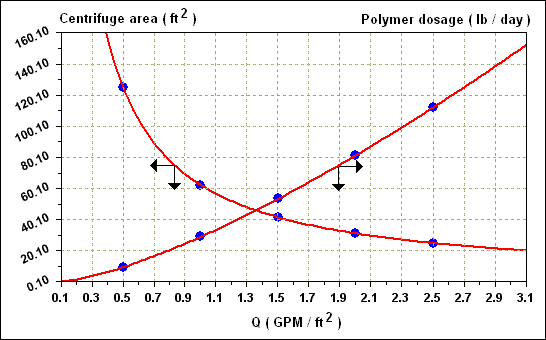
The variables that influence the dewatering process are solids concentration, sludge and filtrate viscosity, sludge compressibility, chemical composition, and the nature of the sludge particles ( size, shape, water content, etc. ). The filter operating variables are vacuum, drum submergence and speed, sludge conditioning, and the type and porosity of the filter media. The rate of filtration of sludges has been formulated and according to Poiseuille's and Darcy's laws by Carman and Coackley ;
( dV / dt ) = [ ( P ) ( A 2 ) ] / { ( MU ) [ ( r ) ( c ) ( V ) + ( R M ) ( A ) ] }
Where ; V : volume of filtrate, t : cycle time ( approximate form time in continuous drum filters ), P : vacuum, A : filtration area, MU : filtrate viscosity, r : specific resistance and c : weight of solids / unit volume of filtrate.
c = 1 / { [ ( c I ) / ( 100 - c I ) ] - [ ( c F ) / ( 100 - c F ) ] }
Where ; c I : initial % moisture content and c F : final % moisture content.
R M , the initial resistance of the filter media, can usually be neglected as small compared to the resistance developed by the filter cake. The specific resistance r is a measure of the filterability of the sludge and is numerically equal to the pressure difference required to produce a unit rate of filtrate flow of unit viscosity through a unit weight of cake. Integration and rearrangement of the equation yields ;
( t / V ) = { [ ( MU ) ( r ) ( c ) ] / [ ( 2 ) ( P ) ( A 2 ) ] } ( V ) + [ ( MU ) ( R M ) ] / [ ( P ) ( A ) ]
From equation given above, a linear relationship will result from a plot of t / V against V. The specific resistance can be computed from the slope of this plot ;
r = [ ( 2 ) ( b ) ( P ) ( A 2 ) ] / [ ( MU ) ( c ) ]
Where ; b : slope of the t / V against V plot. Although specific resistance has limited value for the calculation of filtration rates on drum filters, it provides a valuable tool for the evaluation of vacuum filtration variables and the relative filterability of sludges. Typical values are given in table shown below.
| Description | Specific resistance ( s 2 / g ) x 10 7 | Coefficient of compressibility |
| Activated ( digested ) | 800 | - |
| Primary ( raw ) | 1,310 - 2,110 | - |
| Primary ( digested ) | 1,350 | 25 |
| Activated sludge + 13.5 % Fe Cl 3 | - | 45 |
| Vegetable processing sludge | 46 | 7 |
| Vegetable tanning | 15 | 20 |
| Lime neutralization acid mine drainage | 30 | 11 |
| Aluminum processing | 3 | 0.44 |
| Paper industry | 6 | - |
| Distillery | 200 | 1.30 |
| Petroleum industry | 10 - 100 | 0.50 - 0.70 |
r = ( r O ) ( P S )
Where ; s : coefficient of compressibility.
The greater the value of s, the more compressible is the sludge. When s = 0, the specific resistance is independent of pressure and the sludge is incompressible.
- A = 104.6 cm 2
- P = 15 in Hg = 526 g / cm 2
- MU = 0.00895 g / cm . sec
- c I = 0.044 g / mL ( solids ) or 95.6 % moisture
- c F = 0.200 g / mL ( solids ) or 80.0 % moisture
Determine the specific resistance.
| Time ( sec ) | Volume ( mL ) | t / V ( sec / mL ) |
| 14.5 | 66 | 0.22 |
| 29.5 | 92 | 0.31 |
| 45.0 | 112 | 0.40 |
| 59.0 | 129 | 0.46 |
| 70.0 | 134 | 0.52 |
| 89.0 | 156 | 0.57 |
| 105.0 | 167 | 0.63 |
| 120.0 | 174 | 0.69 |
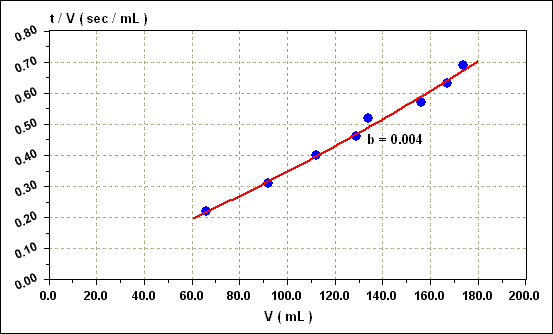
The solids deposited per unit volume of filtrate is calculated by ;
c = 1 / { [ ( c I ) / ( 100 - c I ) ] - [ ( c F ) / ( 100 - c F ) ] }
c = 1 / { [ ( 95.6 ) / ( 100 - 95.6 ) ] - [ ( 80.0 ) / ( 100 - 80.0 ) ] } = 0.056 g / mL
The specific resistance is ;
r = [ ( 2 ) ( b ) ( P ) ( A 2 ) ] / [ ( MU ) ( c ) ]
r = [ ( 2 ) ( 0.004 ) ( 526 ) ( 104.6 2 ) ] / [ ( 0.00895 ) ( 0.056 ) ] = 9.19 x 10 7 sec 2 / g
L F = ( 35.7 ) { [ ( c ) ( P 1 - s ) ] / [ ( MU ) ( R O ) ( t F ) ] } 1 / 2
Where ; R O = r O x 10 - 7 ( sec 2 / g ), P : vacuum ( psi ), c : solids deposited per unit volume filtrate ( g / mL ), MU : filtrate viscosity ( centipoises ), t F : form cycle time ( min ) and L F : filter loading ( lb / ft 2 . hr ). This equation should be modified for the prediction of filtration rates for various types of sludges ;
L F = ( 35.7 ) { [ ( P 1 - s ) ] / [ ( MU ) ( R O ) ] } 1 / 2 ( c m / t F n )
Filter operation has shown the exponent n to vary from 0.4 to 1.0. The effect of variation on solids content fed to the filter will likewise vary m from 0.25 to 1.0. Final cake moisture is related to the cake thickness, the drying time, the pressure drop across the cake, the liquid viscosity, and the air rate through the cake. The drying time increases to a maximum beyond which very little increase will occur. In a very porous cake, the change in cake moisture with increased drying time or increased vacuum is small, because the high air rates through the cake cause a rapid initial drying to equilibrium. Nonporous cakes require longer drying times and high vacuum to attain a maximum cake solids content. Typical plots of experimental vacuum filtration analysis are shown in figure given below.
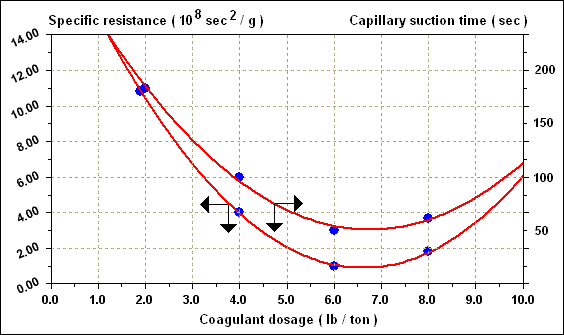
The filter loading from equation given above is in terms pf form time. This is conventionally converted to cycle time for final specification and design ;
L C = ( L F ) ( % Submergence / 100 ) ( 0.80 )
The factor 0.80 compensates for the area of the filter drum where the cake is removed and the media washed. The total cycle time on a filter may vary from 1 to 6 minutes. Submergence of the drum may vary from 10 to 60 percent resulting in a maximum spread of form time of 0.1 to 3.5 minutes. This also yields a maximum spread of dry time of 2.5 to 4.5 minutes. In general, the filter yield from highly compressible cakes is relatively unaffected by increases in form vacuum varying from 12 to 17 in. ( 30 to 43 cm ) of Hg. The vacuum filtration characteristics of several sludges are summarized in table given below.
| Sludge | Concentration ( % ) |
Cake ( % ) |
Filtration rate ( lb / ft 2 . hr ) ( kg / m 2 . hr ) |
Chemicals ( % by wt ) |
| Primary sewage undigested | 6 - 10 | 66 - 69 | 6.9 33.7 |
1.0 - 2.0 A 6.0 - 9.0 B |
| Primary sewage digested | 6 - 10 | 70 - 73 | 7.2 35.2 |
2.5 - 3.5 A 7.0 - 12.0 B |
|
High rate trickling filter mixed primary and secondary |
7 | 68 - 75 | 7.1 34.7 |
1.5 - 2.5 A 7.0 - 11.0 B |
|
High rate trickling filter mixed primary and secondary digested mixture |
7 | 71 | - |
3.5 A 9.0 B |
| A : Ferric chloride, B : Lime | ||||
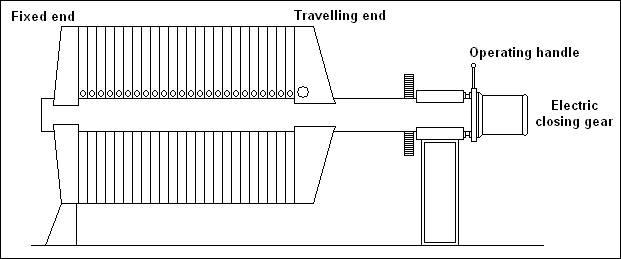
| Sludge type | Suspended solids ( % ) |
Conditioning of dry solids ( % ) |
Cake solids ( % ) |
Time cycle ( hr ) |
| Raw primary | 5 - 10 | Ash : 100 FeCl 3 : 5 - Lime : 10 |
50 45 |
1.5 2.0 |
| Raw primary with less than 50 % AS | 3 - 6 | Ash : 150 FeCl 3 : 5 - Lime : 10 |
50 45 |
2.0 2.5 |
| Raw primary with more than 50 % AS | 1 - 4 | Ash : 200 FeCl 3 : 6 - Lime : 12 |
50 45 |
2.0 2.5 |
| Digested and, digested with less than 50 % AS | 6 - 10 | Ash : 100 FeCl 3 : 5 - Lime : 10 |
50 45 |
1.5 2.0 |
| Digested and, digested with more than 50 % AS | 2 - 6 | Ash : 200 FeCl 3 : 7.5 - Lime : 15 |
50 45 |
1.5 2.5 |
| AS ( Activated sludge ) | Up to 5 | Ash : 250 FeCl 3 : 7.5 - Lime : 15 |
50 45 |
2.0 2.5 |
| Feed solids ( % ) |
Secondary : Primary ratio | Polymer dosage ( lb / ton dry solids ) |
Pressure ( psig ) |
Cake solids ( % ) |
Solids recovery ( % ) |
Capacity ( lb dry solids / m . hr ) |
| 9.5 | 100 % primary | 1.6 | 100 | 41 | 98 | 2,706 |
| 8.5 | 1 : 5 | 2.4 | 100 | 38 | 98 | 2,706 |
| 7.5 | 1 : 2 | 2.7 | 25 - 100 | 33 - 38 | 96 | 1,485 |
| 6.8 | 1 : 1 | 2.9 | 25 | 31 | 95 | 898 |
| 6.5 | 2 : 1 | 3.1 | 25 | 31 | 95 | 858 |
| 6.1 | 3 : 1 | 4.1 | 25 | 28 | 93 | 605 |
| 5.5 | 100 % secondary | 5.5 | 25 | 25 | 95 | 546 |
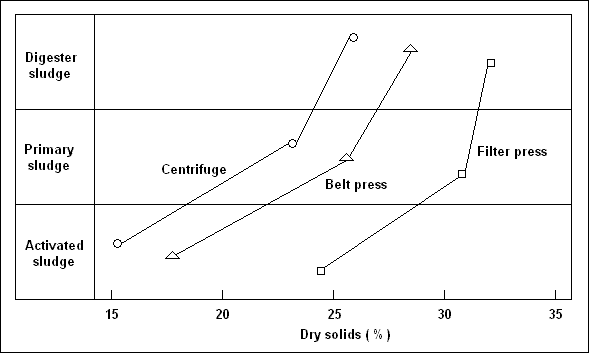
Klein Co. developed a belt filter press ( see figure given below ) that employed not only the concept of cake shear with simultaneous application of pressure but also low pressure filtration and thickening by gravity drainage. An endless filter belt ( A ) runs over a drive and guide roller at each and ( B and C ) like a conveyor belt. The upper side of the filter belt is supported by several rollers ( D ). Above the filter bed a press belt ( E ) runs in the same direction and the same speed. The drive roller for this belt ( F ) is coupled with the drive roller ( B ) of the filter. The press belt can be pressed on the filter belt by means of a pressure roller system whose rollers ( G ) can be individually adjusted horizontally and vertically. The sludge to be dewatered ( H ) is fed on the upper face of the filter belt and is continuously dewatered between the filter and press belts. Note how the supporting rollers of the filter belt and the pressure rollers of the pressure belt are adjusted in such a way that the belts and the sludge between them describe an S - shaped curve. This configuration induces parallel displacement of the belts relative to each other due to the difference in radius producing shear in the cake. After dewatering in the shear zone, the sludge is removed by a scraper ( I ).
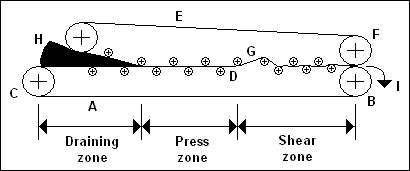
* 1 - s = 0.087
* m = 0.548
* n = 0.562
* R O = 3.5 sec 2 / g
* Cake solids = 34 %
* Cycle time = 6 min
c = 1 / { [ ( c I ) / ( 100 - c I ) ] - [ ( c F ) / ( 100 - c F ) ] }
c = 1 / { [ ( 94.74 ) / ( 100 - 94.74 ) ] - [ ( 66.00 ) / ( 100 - 66.00 ) ] } = 0.0622 g / mL
The filter loading is ;
L F = ( 35.7 ) { [ ( P 1 - s ) ] / [ ( MU ) ( R O ) ] } 1 / 2 ( c m / t F n )
L F = ( 35.7 ) { [ ( 9.8 0.087 ) ] / [ ( 1.0 ) ( 3.5 ) ] } 1 / 2 ( 0.0622 0.548 / 6 0.562 ) = 1.86 lb / ft 2 . hr
The weight of sludge solids is ;
W = ( 52,600 ) ( 0.0296 ) ( 8.34 ) = 13,000 lb / day
The required vacuum filter area is ;
A = ( W ) / ( L ) = ( 13,000 ) / ( 1.86 x 24 ) = 292 ft 2
| Source or type of sludge |
Solids applied ( % ) |
Volume ( % ) |
Depth applied ( m ) |
Period to liftable state ( days ) |
Solids content removed ( % ) |
Specific resistance ( 10 9 sec 2 / g ) ( 500 g / cm 2 ) |
Coefficient of comp. |
| Steam peeling or carrots | 1.91 | 74.3 | 39.4 | 25 | 7.0 | 0.46 | 1.02 |
| Lime neutralization of pickling liquor | 2.46 | 16.9 | 48.3 | 25 | 10.5 | 0.30 | 0.63 |
| Vegetable tanning | 6.79 | 43.5 | 19.5 | 20 | 20.0 | 0.15 | 0.79 |
|
Lime neutralization of regenerant liquors from ion - exchange demineralization of plating wastes |
7.05 | 19.8 | 17.5 | 20 | 18.0 | 0.19 | 0.55 |
| Alum sludge | 4.82 | 56.8 | 30.5 | 74 | 25.0 | 13.50 | 0.60 |
| Digested sewage sludge | 4.28 | 56.8 | 30.5 | 74 | 25.0 | 13.50 | 0.60 |
| Type of digested sludge |
Area ft 2 / capita ( m 2 / capita ) |
Area lb of dry solids / ft 2 . year |
| Primary | 1.0 ( 0.09 ) | 30 |
| Primary and trickling filter | 1.6 ( 0.11 ) | 25 |
| Primary and activated sludge | 3.0 ( 0.28 ) | 20 |
| Chemically precipitated sludge | 2.0 ( 0.19 ) | 22 |
( a ) Area of bed : Assuming 5 dryings of sludge 8 in. in depth annualy, the bed area is [ ( 9 ) ( 365 ) ] / [ ( 5 ) ( 1,000 ) ( 8 / 12 ) ] = 1.0 sq ft per capita. This is a common figure for open beds in the northern US.
( b ) Volume of sludge cake : Assuming 50 % reduction in volume of sludge during drying, the volume of dried cake becomes [ ( 0.50 ) ( 9 ) ( 365 ) ] / [ ( 27 ) ( 1,000 ) ] = 0.06 cu yd per capita annually.
Metal equivalent of sludge = ( Zn + 2 Cu + 4 Ni ) / ( 500 )
Total metal equivalents that can be applied ( lbs / acre ) = ( 65 ) ( CEC )
Cadmium is considered separately ;
Cd = 10 lbs / acre ( lifetime application ) and 2 lbs / acre . year ( maximum )
Suggested maximum heavy metals can be applied are shown in table given below.
| Metal ( lbs / acre ) | Soil CEC ( meq / 100 g ) | ||
| 0 - 5 | 5 - 15 | 15 - 20 | |
| Zn | 225 | 450 | 900 |
| Cu | 110 | 225 | 450 |
| Ni | 45 | 90 | 180 |
| Cd | 4.5 | 9 | 18 |
| Pb | 450 | 900 | 1,800 |
- Quantity = 6,560 gallons / day
- Amount = 3,500 pounds / day
- NH 3 = 235 mg / L
- Organic - N = 865 mg / L
- SS = 63,000 mg / L
- PO 4 = 30 mg / L
Metal analysis of sludge :
- Al = 700 mg / kg dry solid
- Cd = 3.0
- Ca = 105,000
- Cr = 400
- Cu = 60
- Fe = 6,000
- Pb = 30
- Ni = 150
- Zn = 120
- K = 150
Average CEC of the soil :
- CEC AVERAGE = 16.8 meq / 100 g
- Metal equivalent of sludge = ( Zn + 2 Cu + 4 Ni ) / ( 500 ) = ( 120 + 2 x 60 + 4 x 150 ) / ( 500 ) = 1.68 lbs / ton sludge
- Total sludge can be applied = ( 65 ) ( CEC ) = ( 65 ) ( 1.68 ) = 1,092 lbs / acre
- Sludge application = ( 1,092 ) / ( 1.68 ) = 650 tons / acre ( lifetime )
- Maximum allowable sludge application = 650 tons / acre ( lifetime )
Bermuda grass :
- 200 lbs / acre for nitrogen loading
Subsurface incorporation :
- 100 % NH 3 availability
- 40 % Organic - N availability
Agronomic loading :
* Available N for the 1 st year application
- Total N = ( 235 ) + ( 865 ) ( 0.4 ) = 581 mg / L = 0.00486 lbs / gal
- Sludge loading = ( 200 ) / ( 0.00486 ) = 41,126 gal / acre
- Area required = [ ( 6,560 ) ( 365 ) ] / ( 41,126 ) = 58 acre
* Project life of the plot based on CEC
- Sludge concentration = 63,000 mg / L = 0.53 lbs / gal
- Sludge applied = ( 0.53 ) ( 41,126 ) = 21,684 lbs / acre = 10.8 tons / acre
- Years of application = ( 650 ) / ( 10.8 ) = 60.2 years
* Based on Cd content in the sludge
- Rate = ( 3.0 ) ( 31,324 / 2.2 ) ( 1 / 1,000 ) ( 1 / 454 ) = 0.094 lbs / acre
- Years of application = 106 years
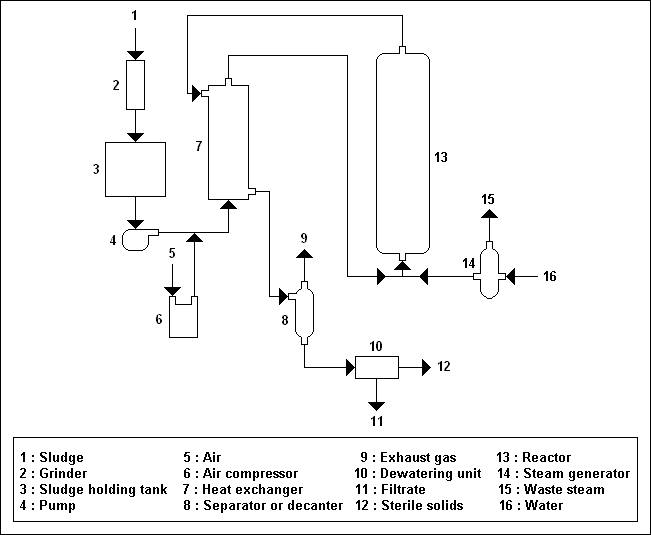
| Dewatering unit / Type of sludge | Feed ( % ) |
Cake ( % ) |
Cycle ( sec ) |
Yield ( lb / ft 2 . hr ) |
| Vacuum filter | ||||
| Waste activated | 12.5 | 36.7 | 135 | 7.2 |
| Raw primary | 6.0 | 43.8 | 67 | 39.5 |
| Digested primary | 10.5 | 38.5 | 100 | 21.7 |
| Filter press | ||||
| Waste activated | 6.8 | 53.3 | 120 | 8.7 |
| Dewatering unit / Type of sludge | Feed ( % ) |
Cake ( % ) |
Feed rate ( lb / hr ) |
Recovery ( % ) |
| Solid bowl centrifuge | ||||
| Waste activated | - | 38.8 | 66 | 91.7 |
| Waste activated | - | 36.0 | 102 | 96.7 |
| Raw primary and waste activated | - | 41.6 | 77 | 96.4 |
| Raw primary and waste activated | - | 51.3 | 181 | 89.4 |
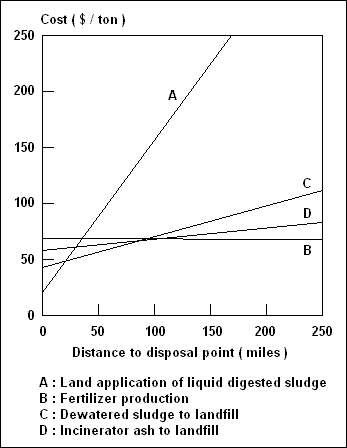
| Description of tested sludge | Combustible ( % ) | Ash ( % ) | Heat value ( BTU / lb ) |
| Oil | - | - | 17,500 |
| Grease and scum | 88.5 | 11.5 | 16,750 |
| Raw wastewater | 74.0 | 26.0 | 10,285 |
| Fine screenings | 86.4 | 13.6 | 7,820 |
| Waste sulfite liquor solids | - | - | 7,900 |
| Primary wastewater sludge | - | - | 8,990 |
| Activated wastewater sludge | - | - | 6,540 |
| Semichemical pulp solids | - | - | 5,812 |
| Digested primary sludge | 59.6 | 40.4 | 5,290 |
| Grit | 33.2 | 69.8 | 4,000 |
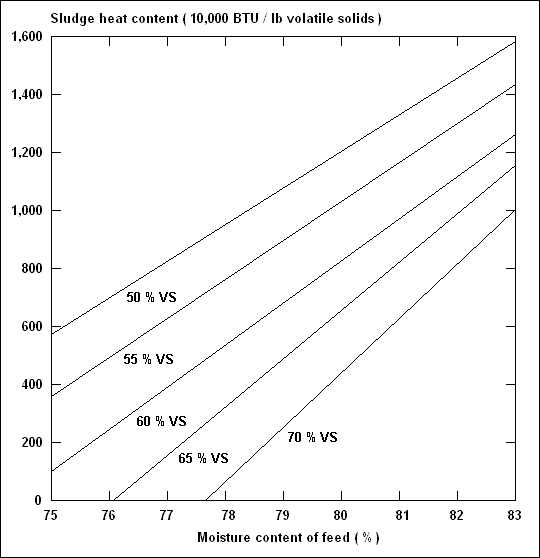
Area of vacuum filter :
- The daily weight of dry solids is ;
( 7,000 ) ( 8.34 ) ( 1.002 ) ( 0.015 ) = 880 lb
- Assuming that each percent of Fe Cl 3 increases the dry solids in the ratio of the molecular weight of Fe ( OH ) 3 to that of Fe Cl 3 , or 106.8 to 162.2, the added chemical increases the weight of sludge by 0.66 % for each percent of Fe Cl 3 . Hence the additional weight is ( 6 ) ( 0.66 ) ( 880 / 100 ) = 35 lb. Assuming an allowable filter loading of 2.5 lb / ft 2 . hr, the required filter area is then found to be ( 880 + 35 ) / [ ( 24 ) ( 2.5 ) ] = 15.2 ft 2 .
Auxiliary heat required to incinerate :
- The fuel value of the cake ; ( 107 ) { { [ ( 100 ) ( 70 ) ] / [ 100 - ( 6 ) ( 0.66 ) ] } - 5 } { [ 100 - ( 6 ) ( 0.66 ) ] / ( 100 ) } = 7,000 BTU / lb
If the filter cake contains 20 % solids and the efficiency of evaporation and incineration is 55 %, the heat requirements are [ ( 1,124 ) ( 100 - 20 ) ] / [ ( 20 ) ( 0.55 ) ] = 8,100 BTU / lb. Auxiliary heat must, therefore, be provided in an amount of ( 880 + 35 ) ( 8,100 - 7,000 ) = 1.0 million BTU / day.
